Acute Abdomen课件
合集下载
最新急腹症的诊断和治疗 PPT课件

(一)病史询问 ( History demand)
1、发病的情况(Episode condition) 发病的诱因、起病的缓急、症状出现的先后主次和演变过程等
饱餐后的腹痛——胃、十二指肠溃疡穿孔、胆囊炎、胰腺炎 腹部受伤后发生腹痛——内出血、或空腔脏器破裂 剧烈运动后腹痛——肠扭转或尿路结石 先发热后有腹痛——内科病
急腹症的诊断和治疗 PPT课件
急腹症(Acute abdomen)
是一类以急性腹痛为突出表现 需要早期诊断和及时处理的腹部疾病
急腹症的特点(Characteristic of acute abdomen)
1、起病急、进展快、变化多、病情重; 2、需及时而正确地做出早期诊断和治疗
否则会延误时机,造成严重后果
扪诊—— 注意腹部有无压痛、肌紧张和反跳痛等腹膜 刺激症状,同时注意其部位、范围和程度 急性阑尾炎早期——自觉疼痛可在上腹或脐周 但压痛仍在右下腹
溃疡病穿孔——全腹虽有压痛和肌紧张, 但在上腹 病灶部位最为明显
蛔虫性肠梗阻和绞窄性肠梗阻——往往可扪及包块 蛔虫团块有条索感,肠套叠肿块呈腊肠样
叩诊——重点注意有无肝浊音界消失和移动性浊音 听诊——注意肠鸣音是否亢进、减弱甚至消失,有无
——炎症和梗阻并存,且互为因果所致 绞窄性肠梗阻,一般先有梗阻的阵发绞痛,发生 血运障碍继发感染加重后, 出现持续疼痛阵发加剧 胆道梗阻一旦并发感染情况也是如此
3、腹痛的程度(Degree of abdomen pain)
急性炎症——腹痛一般较轻,可以忍受 管道梗阻——绞痛通常都较剧烈 胃、十二指肠溃疡穿孔 出血性胰腺炎和宫外孕破裂——疼痛最为剧烈
测量病人的生命征体温、注意有无休克、脱水 结合病史,重点注意有无某种特殊表现 疑有胆道疾——应注意有无巩膜黄染 疑有内出血——应注意眼结膜是否苍白 疑有肠梗阻——应注意有无腹壁切口疤痕
外科学急腹症acute abdomen的诊断课件
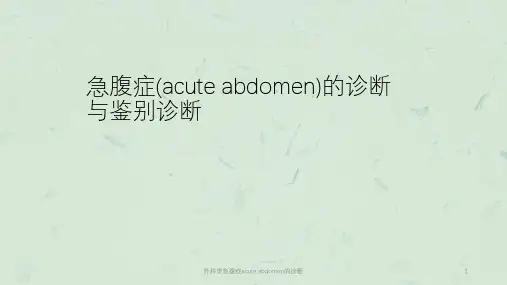
贫血休克
外科学急腹症acute abdomen的诊断
6
• 2.月经史:准确的月经史,近期月经开始
•
和终止日期对腹痛的诊断有重
•
要意义。如宫外孕破裂多有
•
停经史,卵巢滤泡获黄体破裂
•
常在两次月经的中期发病。
• 3.既往史:以前的疾病史或手术史对腹痛
•
的诊断也是有价值的。
外科学急腹症acute abdomen的诊断
12
正常肠系膜上动脉造影
外科学急腹症acute abdomen的诊断
13
内镜检查(梗死)
外科学急腹症acute abdomen的诊断
14
常见急腹症的诊断和鉴别诊断要点
▪ 胃十二指肠溃疡急性穿孔
根据过去的溃疡病史,突然发生的持续性上腹剧烈疼痛很快扩散到全腹。 体格检查有明显的腹膜刺激征肝浊音界缩小或消失。X线检查膈下有游离气 体。
•
阑尾盆腔内病变迅速评价的首选
•
方法。
• 4.CT
• 5.内镜检查
• 6.动脉造影
• 7.诊断性腹腔穿刺或灌洗。
外科学急腹症acute abdomen的诊断
10
腹腔积液积气
Hydropneumoperitoneum
外科学急腹症acute abdomen的诊断
11
阑尾炎CT
外科学急腹症acute abdomen的诊断
▪ 急性胰腺炎
• 多于暴饮暴食或饮酒后发病,上腹偏左侧腹痛,持
续剧烈,可向肩部放射。恶心呕吐后腹痛不缓解。化验 血或尿淀粉酶明显升高。CT检查胰腺弥漫性肿大,密度 不均,胰腺坏死时呈皂泡征,胰周积液。
外科学急腹症acute abdomen的诊断
外科学急腹症acute abdomen的诊断
6
• 2.月经史:准确的月经史,近期月经开始
•
和终止日期对腹痛的诊断有重
•
要意义。如宫外孕破裂多有
•
停经史,卵巢滤泡获黄体破裂
•
常在两次月经的中期发病。
• 3.既往史:以前的疾病史或手术史对腹痛
•
的诊断也是有价值的。
外科学急腹症acute abdomen的诊断
12
正常肠系膜上动脉造影
外科学急腹症acute abdomen的诊断
13
内镜检查(梗死)
外科学急腹症acute abdomen的诊断
14
常见急腹症的诊断和鉴别诊断要点
▪ 胃十二指肠溃疡急性穿孔
根据过去的溃疡病史,突然发生的持续性上腹剧烈疼痛很快扩散到全腹。 体格检查有明显的腹膜刺激征肝浊音界缩小或消失。X线检查膈下有游离气 体。
•
阑尾盆腔内病变迅速评价的首选
•
方法。
• 4.CT
• 5.内镜检查
• 6.动脉造影
• 7.诊断性腹腔穿刺或灌洗。
外科学急腹症acute abdomen的诊断
10
腹腔积液积气
Hydropneumoperitoneum
外科学急腹症acute abdomen的诊断
11
阑尾炎CT
外科学急腹症acute abdomen的诊断
▪ 急性胰腺炎
• 多于暴饮暴食或饮酒后发病,上腹偏左侧腹痛,持
续剧烈,可向肩部放射。恶心呕吐后腹痛不缓解。化验 血或尿淀粉酶明显升高。CT检查胰腺弥漫性肿大,密度 不均,胰腺坏死时呈皂泡征,胰周积液。
外科学急腹症acute abdomen的诊断
Acute Abdomen课件共29页文档
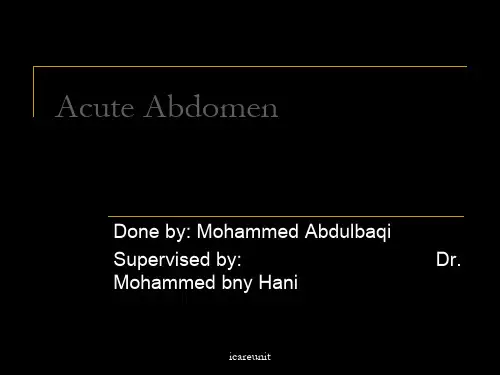
icareunit
Signs
SIGNS are objective and reproducible findings Tenderness Rigidity Masses Altered bowel sounds Evidence of malnutrition Bleeding Jaundice
(Non-Traumatic) Etiologies Can Be Trivial or Life-Threatening
icareunit
Challenge to surgeons & physicians. Most common cause of surgical emergency
Acute Abdomen
Done by: Mohammed Abdulbaqi
Supervised by:
Dr.
Mohammed bny Hani
icareunit
Definition
Primary Symptom Is Abdominal Pain Pain Has Lasted Less Than 24 hours Medical or Surgical Diagnoses
icareunit
Visceral Pain
Stimuli Distention of the gut or other hollow abdominal organ Traction on the bowel mesentery Inflammation Ischemia Sensation Corresponds to the embryologic
Diaphragmatic irritation
Signs
SIGNS are objective and reproducible findings Tenderness Rigidity Masses Altered bowel sounds Evidence of malnutrition Bleeding Jaundice
(Non-Traumatic) Etiologies Can Be Trivial or Life-Threatening
icareunit
Challenge to surgeons & physicians. Most common cause of surgical emergency
Acute Abdomen
Done by: Mohammed Abdulbaqi
Supervised by:
Dr.
Mohammed bny Hani
icareunit
Definition
Primary Symptom Is Abdominal Pain Pain Has Lasted Less Than 24 hours Medical or Surgical Diagnoses
icareunit
Visceral Pain
Stimuli Distention of the gut or other hollow abdominal organ Traction on the bowel mesentery Inflammation Ischemia Sensation Corresponds to the embryologic
Diaphragmatic irritation
Acute Abdomen课件 28页PPT
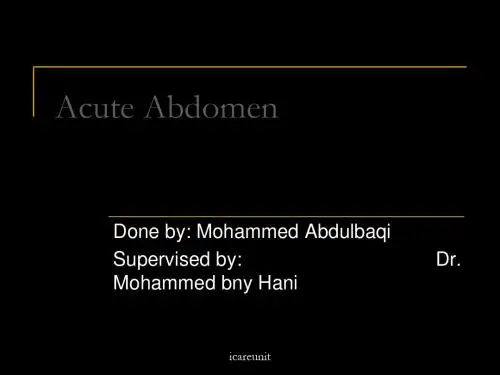
Retrocecal appendicitis
Shift of pain, tenderness
Right lower lobe pneumonia
Fever, tachypnea, bronchial icareubnitreathing
Left Upper Quadrant (LUQ) and Epigastric Pain
Colicky pain, hematuria
Tender, swollen testis, young age
icareunit
Example: McBurney’s point in late appendicitis
icareunit
Patterns of Referred Pain
Gastric pain Liver and biliary pain Colonic pain Uretral or kidney pain
origin of the diseased organ (foregut,midgut, hindgut)
icareunit
Somatic Pain
Stimuli Irritation of the peritoneum Sensation Sharp, localized pain Easily described Cardinal signs Pain Guarding Rebound Absent bowel
flatulence
icareunit
The Physiology of Abdominal Pain
Abdominal pain from any cause is mediated by either visceral or somatic afferent nerves Several factors can modify expression of pain Age extremes Vascular compromise (pain ‘out of proportion’) Pregnancy CNS pathology Neutropenia
急腹症ppt课件
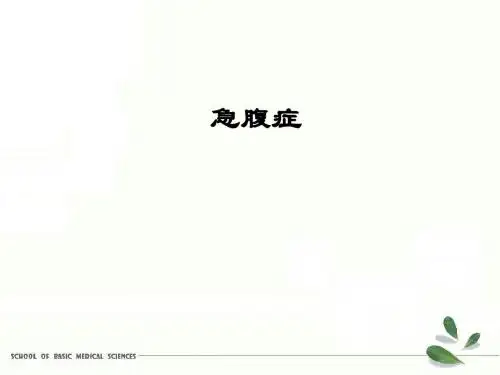
急腹症的诊断
• 2、诊断方法及要点: 1).收集病史是打开诊断门户的钥匙 要求: 对病人热情,取得病人信任和配合; 既要针对性系统化,又要注意提问方式,以 防暗示或诱导; 艺术性与真实性相结合,最终达到系统、真 实而又重点突出。
急腹症的诊断
• 内容: 一般项目:姓名、性别、年龄、籍贯、 婚姻
主诉和现病史; 既往史; 个人史:婚姻、生育、月经史、家族史
急腹症的诊断
• 2).体格检查是诊断的客观依据
腹部检查基本要求:
a. 标准腹部检查体位:仰卧,屈髋屈膝4060°, 双膝稍拢,双手自然放于躯干两侧 b. 充分暴露,上至乳头线,下到大腿中上段, 两侧至腋后线 c. 检查顺序:“视、触、叩、听” 最好加上“肛、殖、量、穿”
急腹症的诊断
• 视诊(内容) 腹部呼吸运动: 腹壁、皮肤:手术疤痕、静脉曲张 腹部外形: 腹部隆起 腹部凹陷 蠕动波及肠型: 腹股沟、外生殖器、会阴:
急腹症的诊断
• 右下腹疼痛
1. 急性阑尾炎
2. 肠结核
3.Crohn病 4.卵巢蒂扭转 5.右侧输尿管结石 6. 异位妊娠
急腹症的诊断
• 左下腹疼痛
1. 急慢性肠炎
2.
3. 4. 5. 6.
细菌性痢疾
溃疡性结肠炎 大肠癌 肠易激综合征 左侧输尿管结石
急腹症的诊断
• 全腹疼痛 1.消化性溃疡穿孔
准, 不少于1分钟
急腹症的诊断
• “肛、殖、量、穿”检查,无需特殊器械 ,首诊医生可以独立完成,对提高确诊、 减少误诊、漏诊有很大帮助。 肛:肛门指检、肛镜检查 殖:生殖及阴道检查 量:量诊,量肝、脾大小、腹围大小 穿:腹腔穿刺及灌洗术
应性腹痛。这一感觉过敏或疼痛区称为海德氏带(Head’s Zones)。
(医学课件)急腹症Acute_abdomenppt演示课件
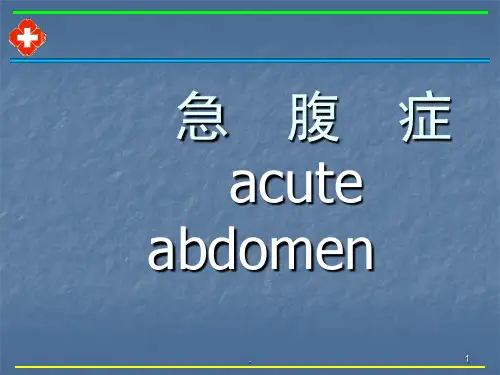
急 腹 症 acute abdomen
. 1
急 腹 症
腹痛的机制 腹痛的病因 常见脏器的腹痛 急腹症的诊断与鉴别诊断 诊断原则和经验教训
急腹症的处理 .
2
急腹症定义
急腹症(acute
急性腹痛 为主要表现,起病急、进展快,常 需以手术治疗为主要手段的若干腹部 疾病。(狭义) 凡以急性腹痛作为主诉或主要临床表 现均可称为急腹症。(广义)
12
三、常见脏器的腹痛
食管 胸1~胸6。常在胸骨后;伴吞咽 困难和疼痛。 胃与十二指肠 胸7~胸9。在中上腹; 放射右肩背;与饮食有关;因进食、 抗酸剂或呕吐而减轻;夜间加重。 胰腺 胸12~腰2。头部病变位于中线 右侧;胰体病变痛在脐周或中线部位; 胰尾病变在中线左侧;疼痛常可感觉
. 13
“一类以急性腹痛为突出表现,需早
. 3
abdomen)是一组以
急腹症
腹痛为急腹症的主要表现形式,处理的正 确与否对病人的安危有很大的关系。 病因极为复杂,包括炎症、肿瘤、出血、 梗阻、穿孔、创伤及功能障碍等。 特点为发病急、进展快、变化多、病情重。 外科急腹症常需外科方法处理或病情发展 有需外科处理的可能性。 急腹症时的两个重要问题是鉴别和决断。
常见脏器的腹痛
小肠 胸10。疼痛部位在脐周;通常为 绞痛性质。
结肠 胸8~胸12。部位:横乙结肠痛在 脐与耻骨之间,升结肠痛在脐右,降 结肠在脐左,直肠在耻骨上或腰骶部; 可为绞痛;排便减轻;伴脓血或粘液。 肾与输尿管 胸12~腰1。属于躯体痛,
. 14
四、急腹症的诊断与鉴别诊断
详细的病史 细心的检体 相关的实验室资料 必要的影像学检查 遵循“定性、定位、定因” 及 对征候群“一元化”解释原则,不要 综合分析,对诊断非常重要。
. 1
急 腹 症
腹痛的机制 腹痛的病因 常见脏器的腹痛 急腹症的诊断与鉴别诊断 诊断原则和经验教训
急腹症的处理 .
2
急腹症定义
急腹症(acute
急性腹痛 为主要表现,起病急、进展快,常 需以手术治疗为主要手段的若干腹部 疾病。(狭义) 凡以急性腹痛作为主诉或主要临床表 现均可称为急腹症。(广义)
12
三、常见脏器的腹痛
食管 胸1~胸6。常在胸骨后;伴吞咽 困难和疼痛。 胃与十二指肠 胸7~胸9。在中上腹; 放射右肩背;与饮食有关;因进食、 抗酸剂或呕吐而减轻;夜间加重。 胰腺 胸12~腰2。头部病变位于中线 右侧;胰体病变痛在脐周或中线部位; 胰尾病变在中线左侧;疼痛常可感觉
. 13
“一类以急性腹痛为突出表现,需早
. 3
abdomen)是一组以
急腹症
腹痛为急腹症的主要表现形式,处理的正 确与否对病人的安危有很大的关系。 病因极为复杂,包括炎症、肿瘤、出血、 梗阻、穿孔、创伤及功能障碍等。 特点为发病急、进展快、变化多、病情重。 外科急腹症常需外科方法处理或病情发展 有需外科处理的可能性。 急腹症时的两个重要问题是鉴别和决断。
常见脏器的腹痛
小肠 胸10。疼痛部位在脐周;通常为 绞痛性质。
结肠 胸8~胸12。部位:横乙结肠痛在 脐与耻骨之间,升结肠痛在脐右,降 结肠在脐左,直肠在耻骨上或腰骶部; 可为绞痛;排便减轻;伴脓血或粘液。 肾与输尿管 胸12~腰1。属于躯体痛,
. 14
四、急腹症的诊断与鉴别诊断
详细的病史 细心的检体 相关的实验室资料 必要的影像学检查 遵循“定性、定位、定因” 及 对征候群“一元化”解释原则,不要 综合分析,对诊断非常重要。
急腹症acuteabdomenPPT课件
腹内病变引起腹痛的五类刺激: • 肠道扩张或收缩
2020/9/22
(肌肉、皮肤)
痛刺激
痛觉神经末梢
肌肉、腹腔内脏、腹膜壁层)
Α-δ纤维 C纤维(
• Α-δ纤维:快速传导,产生明确而定位清楚 的冲动;
• C纤维:传导慢,产生模糊的钝痛、绞痛、 2020/9/22
体表标志与腹部内脏神经分布
体表标志 脊 节
2020/9/22
腹痛部位的鉴别诊断
部位 腹 内 病 变
腹外病变
右 十二指肠溃疡穿孔、急性胆 右下肺及胸膜炎症
上 上 囊炎、胆石症、急性肝炎、 、右肾结石或肾盂
腹膜炎、右膈下脓肿等
炎
腹 中 胆道蛔虫症、溃疡病穿孔、 心绞痛、心肌梗死 上 胃痉挛、急性胰腺炎、阑尾 、糖尿病、酸中毒
炎早期、裂孔疝等 部 左 急性胰腺炎、胃穿孔、脾曲 左下肺及胸膜炎症
• 腹腔脏器的病变:
• 炎症:急性胃炎、急性肠炎、胆囊炎、 胰腺炎、腹膜炎。
• 穿孔:胃穿孔、肠穿孔、胆囊穿孔。 • 阻塞和扭转:肠梗阻、胆道结石、胆道
蛔虫症、输尿管结石、急性胃扭转、 大网膜扭转及卵巢囊肿扭转。 •202破0/9/22裂:异位妊娠、卵巢囊肿、脾破裂、
急性腹痛临床分类
炎症性
穿孔性
• 腹部病变 梗阻性
及全腹者多为实质脏器破裂或 空腔脏器穿孔。
2020/9/22
问腹痛
• 牵涉痛或放射痛:如胆道或膈下的 疾患可引起右肩或肩胛下疼痛;胰 腺位腹膜后,疼痛常涉及后腰背。 疾病不同阶段的牵涉痛,可引起腹 痛部位的转移,好阑尾炎的疼痛。
• 腹痛的性质:持续性钝痛或隐痛多 表示炎症性或出血性病变 ;阵发 性腹痛多表示空腔脏器发生痉挛或
常提示有肠道的感
2020/9/22
(肌肉、皮肤)
痛刺激
痛觉神经末梢
肌肉、腹腔内脏、腹膜壁层)
Α-δ纤维 C纤维(
• Α-δ纤维:快速传导,产生明确而定位清楚 的冲动;
• C纤维:传导慢,产生模糊的钝痛、绞痛、 2020/9/22
体表标志与腹部内脏神经分布
体表标志 脊 节
2020/9/22
腹痛部位的鉴别诊断
部位 腹 内 病 变
腹外病变
右 十二指肠溃疡穿孔、急性胆 右下肺及胸膜炎症
上 上 囊炎、胆石症、急性肝炎、 、右肾结石或肾盂
腹膜炎、右膈下脓肿等
炎
腹 中 胆道蛔虫症、溃疡病穿孔、 心绞痛、心肌梗死 上 胃痉挛、急性胰腺炎、阑尾 、糖尿病、酸中毒
炎早期、裂孔疝等 部 左 急性胰腺炎、胃穿孔、脾曲 左下肺及胸膜炎症
• 腹腔脏器的病变:
• 炎症:急性胃炎、急性肠炎、胆囊炎、 胰腺炎、腹膜炎。
• 穿孔:胃穿孔、肠穿孔、胆囊穿孔。 • 阻塞和扭转:肠梗阻、胆道结石、胆道
蛔虫症、输尿管结石、急性胃扭转、 大网膜扭转及卵巢囊肿扭转。 •202破0/9/22裂:异位妊娠、卵巢囊肿、脾破裂、
急性腹痛临床分类
炎症性
穿孔性
• 腹部病变 梗阻性
及全腹者多为实质脏器破裂或 空腔脏器穿孔。
2020/9/22
问腹痛
• 牵涉痛或放射痛:如胆道或膈下的 疾患可引起右肩或肩胛下疼痛;胰 腺位腹膜后,疼痛常涉及后腰背。 疾病不同阶段的牵涉痛,可引起腹 痛部位的转移,好阑尾炎的疼痛。
• 腹痛的性质:持续性钝痛或隐痛多 表示炎症性或出血性病变 ;阵发 性腹痛多表示空腔脏器发生痉挛或
常提示有肠道的感
Acute Abdomen课件-PPT精选文档29页
Example: McBurney’s point in late appendicitis
icareunit
Patterns of Referred Pain
Gastric pain Liver and biliary pain Colonic pain Uretral or kidney pain
origin of the diseased organ (foregut,midgut, hindgut)
icareunit
Somatic Pain
Stimuli Irritation of the peritoneum Sensation Sharp, localized pain Easily described Cardinal signs Pain Guarding Rebound Absent bowel
icareunit
Physical Examination
Appearance and position of patient Vital signs Appearance of abdomen Distention Hernia Scars
icareunit
Tenderness Rigidity Masses Bowel sounds Rectal and Pelvic Examination Careful exam of heart, lungs and skin
icareunit
Right Lower Quadrant (RLQ) Pain
Investigations Urinalysis (to exclude obvious urinary causes) Pregnancy test Ultrasound Complete blood count
icareunit
Patterns of Referred Pain
Gastric pain Liver and biliary pain Colonic pain Uretral or kidney pain
origin of the diseased organ (foregut,midgut, hindgut)
icareunit
Somatic Pain
Stimuli Irritation of the peritoneum Sensation Sharp, localized pain Easily described Cardinal signs Pain Guarding Rebound Absent bowel
icareunit
Physical Examination
Appearance and position of patient Vital signs Appearance of abdomen Distention Hernia Scars
icareunit
Tenderness Rigidity Masses Bowel sounds Rectal and Pelvic Examination Careful exam of heart, lungs and skin
icareunit
Right Lower Quadrant (RLQ) Pain
Investigations Urinalysis (to exclude obvious urinary causes) Pregnancy test Ultrasound Complete blood count
- 1、下载文档前请自行甄别文档内容的完整性,平台不提供额外的编辑、内容补充、找答案等附加服务。
- 2、"仅部分预览"的文档,不可在线预览部分如存在完整性等问题,可反馈申请退款(可完整预览的文档不适用该条件!)。
- 3、如文档侵犯您的权益,请联系客服反馈,我们会尽快为您处理(人工客服工作时间:9:00-18:30)。
icareunit
Physical Examination: The Quadrants
icareunit
Right Upper Quadrant (RUQ) Pain
Investigations XRay Upright chest Upright and supine abdominal Complete Blood count Urinalysis Amylase, Creatinine, BUN, Electrolytes
icareunit
Right Lower Quadrant (RLQ) Pain
Investigations Urinalysis (to exclude obvious urinary causes) Pregnancy test Ultrasound Complete blood count
Retrocecal appendicitis
Shift of pain, tenderness
Right lower lobe pneumonia
Fever, tachypnea, bronchial icareubnitreathing
Left Upper Quadrant (LUQ) and Epigastric Pain
CLUES
Elderly patient, recurrent
Palpable bladder, difficulty passing urine Dysuria, frequency
Recurrent attacks, diarrhea (+/mucus, blood) Colicky pain, constipation
icareunit
Symptoms
SYMPTOMS reflect a subjective change from normal function:
Pain Appetite: anorexia, nausea, vomiting, dysphagia, weight loss Bowel habits: bloating, diarrhea, constipation,
Pregnancy test Urinalysis to exclude unsuspected urinary
source Ultrasound Complete blood count Upright and supine abdominal XR CT scan if diverticular disease is suspected
admission. Clinical course can vary from minutes to
hours to weeks. It can be an acute exacerbation of a chronic
problem e.g. Chronic Pancreatitis, Vascular insufficiency.
origin of the diseased organ (foregut,midgut, hindgut)
icareunit
Somatic Pain
Stimuli Irritation of the peritoneum Sensation Sharp, localized pain Easily described Cardinal signs Pain Guarding Rebound Absent bowel
icareunit
Differential Diagnosis
CONDITION
Acute appendicitis Mesenteric adenitis Right renal colic Torsed right testis Crohn’s disease
CLUES
Shift of pain, anorexia, localized tenderness Fever, inconstant signs
icareunit
Physical Examination
Appearance and position of patient Vital signs Appearance of abdomen Distention Hernia Scars
icareunit
Tenderness Rigidity Masses Bowel sounds Rectal and Pelvic Examination Careful exam of heart, lungs and skin
CLUES
Splenic rupture Fractured rib pancreatitis
Gastritis / Peptic ulcer disease pneumonia
History of trauma or splenic disease
History of trauma, gross deformity, extreme tenderness on palpation
icareunit
Differential Diagnosis
CONDITION
Diverticular disease Acute urinary retention
Urinary tract infection Inflammatory bowel disease
Large bowel obstruction Left renal colic Torsion of testis
icareunit
Visceral Pain
Stimuli Distention of the gut or other hollow abdominal organ Traction on the bowel mesentery Inflammation Ischemia Sensation Corresponds to the embryologic
CLUES
Fever, cervical excitation, discharge Midcycle, sudden onset
Severe pain, vomiting
Sudden onset, amenorrhea, shock
icareunit
Left Lower Quadrant (LLQ) Pain
icareunit
Differential Diagnosis
CONDITION
Biliary colic, acute cholecystitis
Acute hepatitis Right pyelonephritis Congestive heart failure
CLUES
Recurrent attacks, tender over gall bladder area Alcohol history, jaundice, medications Dysuria, fever, costovertebral angle tenderness Edema, dyspnea, elevated JVP
icareunit
Signs
SIGNS are objective and reproducible findings Tenderness Rigidity Masses Altered bowel sounds Evidence of malnutrition Bleeding Jaundice
icareunit
Nausea? Anorexia? Bowel movements
Number Character Bloody?
Past Medical and Surgical History Travel History Last meal Systemic Review
Colicky pain, hematuria
Tender swollen testis, usually young age Recurrent, several days history
icareunit
Gynecologic Causes of RLQ Pain
CONDITION
Ruptured follicle Torsion of ovary Ruptured ectopic pregnancy Pelvic inflammatory disease
Diaphragmatic irritation
Biliary colic Pancreatic and renal pain Uterine and rectal pain
icareunit
History
Pain When? Where? How? Abrupt, gradual Character Sharp, burning, steady, intermittent Referral? Previous occurrence? Vomiting Relationship to pain How often? How much?
History of alcohol consumption, history of similar event, elevated labs Recurrent, relationship to meals, relationship to posture
Fever, XR findings, bronchial breathing
Example: McBurney’s point in late appendicitis
icareunit
Patterns of Referred Pain
Gastric pain Liver and biliary pain Colonic pain Uretral or kidney pain
Physical Examination: The Quadrants
icareunit
Right Upper Quadrant (RUQ) Pain
Investigations XRay Upright chest Upright and supine abdominal Complete Blood count Urinalysis Amylase, Creatinine, BUN, Electrolytes
icareunit
Right Lower Quadrant (RLQ) Pain
Investigations Urinalysis (to exclude obvious urinary causes) Pregnancy test Ultrasound Complete blood count
Retrocecal appendicitis
Shift of pain, tenderness
Right lower lobe pneumonia
Fever, tachypnea, bronchial icareubnitreathing
Left Upper Quadrant (LUQ) and Epigastric Pain
CLUES
Elderly patient, recurrent
Palpable bladder, difficulty passing urine Dysuria, frequency
Recurrent attacks, diarrhea (+/mucus, blood) Colicky pain, constipation
icareunit
Symptoms
SYMPTOMS reflect a subjective change from normal function:
Pain Appetite: anorexia, nausea, vomiting, dysphagia, weight loss Bowel habits: bloating, diarrhea, constipation,
Pregnancy test Urinalysis to exclude unsuspected urinary
source Ultrasound Complete blood count Upright and supine abdominal XR CT scan if diverticular disease is suspected
admission. Clinical course can vary from minutes to
hours to weeks. It can be an acute exacerbation of a chronic
problem e.g. Chronic Pancreatitis, Vascular insufficiency.
origin of the diseased organ (foregut,midgut, hindgut)
icareunit
Somatic Pain
Stimuli Irritation of the peritoneum Sensation Sharp, localized pain Easily described Cardinal signs Pain Guarding Rebound Absent bowel
icareunit
Differential Diagnosis
CONDITION
Acute appendicitis Mesenteric adenitis Right renal colic Torsed right testis Crohn’s disease
CLUES
Shift of pain, anorexia, localized tenderness Fever, inconstant signs
icareunit
Physical Examination
Appearance and position of patient Vital signs Appearance of abdomen Distention Hernia Scars
icareunit
Tenderness Rigidity Masses Bowel sounds Rectal and Pelvic Examination Careful exam of heart, lungs and skin
CLUES
Splenic rupture Fractured rib pancreatitis
Gastritis / Peptic ulcer disease pneumonia
History of trauma or splenic disease
History of trauma, gross deformity, extreme tenderness on palpation
icareunit
Differential Diagnosis
CONDITION
Diverticular disease Acute urinary retention
Urinary tract infection Inflammatory bowel disease
Large bowel obstruction Left renal colic Torsion of testis
icareunit
Visceral Pain
Stimuli Distention of the gut or other hollow abdominal organ Traction on the bowel mesentery Inflammation Ischemia Sensation Corresponds to the embryologic
CLUES
Fever, cervical excitation, discharge Midcycle, sudden onset
Severe pain, vomiting
Sudden onset, amenorrhea, shock
icareunit
Left Lower Quadrant (LLQ) Pain
icareunit
Differential Diagnosis
CONDITION
Biliary colic, acute cholecystitis
Acute hepatitis Right pyelonephritis Congestive heart failure
CLUES
Recurrent attacks, tender over gall bladder area Alcohol history, jaundice, medications Dysuria, fever, costovertebral angle tenderness Edema, dyspnea, elevated JVP
icareunit
Signs
SIGNS are objective and reproducible findings Tenderness Rigidity Masses Altered bowel sounds Evidence of malnutrition Bleeding Jaundice
icareunit
Nausea? Anorexia? Bowel movements
Number Character Bloody?
Past Medical and Surgical History Travel History Last meal Systemic Review
Colicky pain, hematuria
Tender swollen testis, usually young age Recurrent, several days history
icareunit
Gynecologic Causes of RLQ Pain
CONDITION
Ruptured follicle Torsion of ovary Ruptured ectopic pregnancy Pelvic inflammatory disease
Diaphragmatic irritation
Biliary colic Pancreatic and renal pain Uterine and rectal pain
icareunit
History
Pain When? Where? How? Abrupt, gradual Character Sharp, burning, steady, intermittent Referral? Previous occurrence? Vomiting Relationship to pain How often? How much?
History of alcohol consumption, history of similar event, elevated labs Recurrent, relationship to meals, relationship to posture
Fever, XR findings, bronchial breathing
Example: McBurney’s point in late appendicitis
icareunit
Patterns of Referred Pain
Gastric pain Liver and biliary pain Colonic pain Uretral or kidney pain
